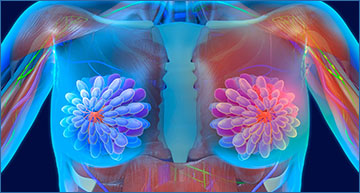Insights from the study of transgender men undergoing androgen therapy may help scientists learn how to use the hormone to prevent or fight a type of breast cancer that is fueled by estrogen.
New insights into the effects of a hormonal treatment for transgender men, discovered by Cedars-Sinai investigators, could have implications for the treatment of breast cancer.
Transgender men who were assigned female at birth and identify today as male may take hormones called androgens to induce physical changes that help them align their physical appearance with their identified gender. Androgens such as testosterone are involved primarily in the development of male traits, although females also produce androgens.
Molecular changes observed in the breast tissue of transgender men undergoing androgen therapy may signal the potential for also using the hormone to prevent or treat a type of breast cancer that is fueled by estrogen. The findings are published in the peer-reviewed journal Cell Genomics.
“These findings build upon previous work showing androgen receptor activation suppresses tumor growth in estrogen receptor-positive breast cancer,” said Simon Knott, PhD, assistant professor of Biomedical Sciences and Medicine at Cedars-Sinai, and senior author of the study. “Androgens seem to counteract the effects of estrogen and could potentially be used to prevent estrogen-driven breast cancers.”
The team of investigators studied breast tissue samples from transgender men undergoing gender-affirming androgen therapy and subcutaneous mastectomy. They compared the samples with breast tissues from cisgender women who had undergone cosmetic breast surgery.
The samples were analyzed using three techniques. The first technique, single-nucleus transcriptomics, involves genetically sequencing nuclear RNA from single cells. This allowed the investigators to understand the types of cells in the breast tissue that were affected by androgen and the genes that were altered. Another technique they applied allowed them to analyze the chromatin of individual cells, making it possible for the investigators to understand the cellular processes behind the observed RNA changes. The third technique employed by investigators involved spatially profiling the tissues, and revealed how androgen therapy altered the organization of cells within the breast tissue.
The investigators observed that in people who underwent androgen therapy, breast cells that normally react to estrogen showed fewer signs of being influenced by the hormone than the same cells from people who did not have the therapy.
People who underwent androgen therapy also produced fewer proteins that aid in the ability of the breasts to produce milk. The therapy instead induced breast cells to translate their genetic information in ways that are typically observed in male breast tissue, where cancer incidence is low. In addition, investigators noted a change in the numbers and composition of the types of immune cells typically seen in breast tissue. This change could hint at the immune system working against the production of cancer cells.
“The most important aspect of this work is that we have created an atlas of every type of breast cell undergoing androgen therapy,” said Florian Raths, a former graduate student at Cedars-Sinai and first author of the study. “This database can be used by other investigators to study cellular changes following androgen exposure.”
Knott said the next step in this line of research would be to study how low doses of androgen given to people at high risk for estrogen receptor-positive breast cancer affects their breast tissue at the molecular level.
“This studies lays the groundwork for discoveries into how androgen and estrogen interact with each other that may contribute to new cancer therapies,” said Dan Theodorescu, MD, PhD, director of Cedars-Sinai Cancer and the PHASE ONE Foundation Distinguished Chair. “Our cancer center is focused on patients and populations such as LGBTQ+ who have historically not been a focus of specific cancer studies. We are trying to change that and to add to the national diversity in cancer research.”
Source – Cedars-Sinai
Raths F, Karimzadeh M, Ing N et al. (2023) The molecular consequences of androgen activity in the human breast. Cell Genomics 3(3), 100272. [article]






